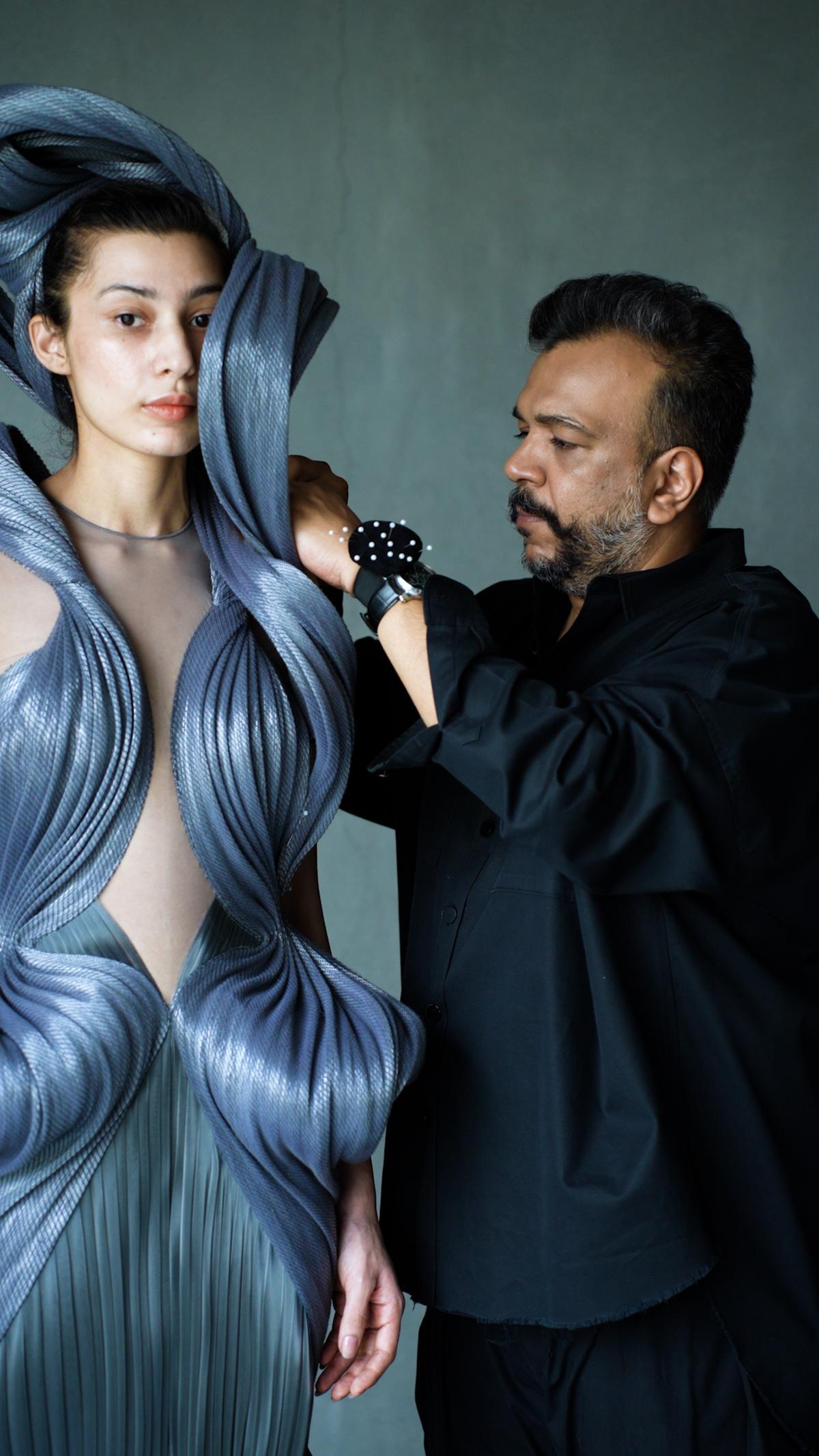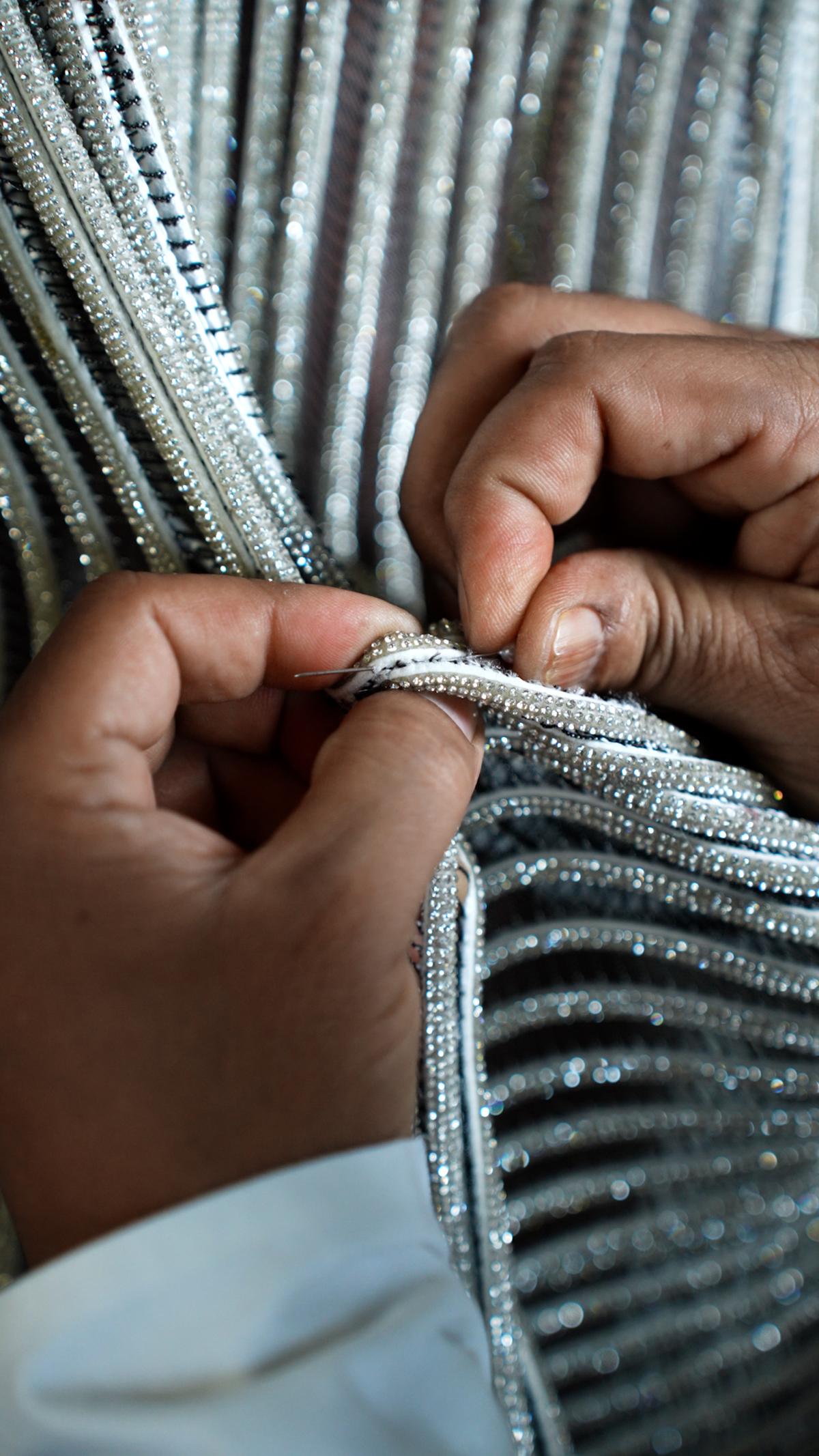Eleven years ago, when Amit Aggarwal delivered his first bridal order, it was black and fashioned from polymer chips. On Sunday, his collection at India Couture Week 2024 continued to defy expectations, as his models walked the runway in futuristic pieces that referenced his fascination with science, philosophy and cosmology. In the sea of wedding lehengas, heavy silk saris and Swarovski-encrusted gowns that made Couture Week, this outlier’s bold experiments with polymer and corded textiles stood tall. One of the 53 looks was a 3D-embellished outfit resembling a cocoon. There were a few gowns inspired by the intricacies of basketry. But what made the biggest impact from his 53 looks was the deep red deconstructed Benaras sari gown on model-turned-jeweler Sapna Kumar.
Crafted from recycled plastics, cotton and industrial materials, Agarwal’s designs celebrate sculptural volume; also seen, one of the six deconstructed Benaras saris | Photo Credit: Special arrangement
Amit, 44, has upcycled older saris in the past. Last year at the launch of the Nita Mukesh Ambani Cultural Center in Mumbai, actor Priyanka Chopra wore a 60-year-old Benaras sari restored by him with silver threads and gold electroplating on khadi silk, structured with a jewel-toned molded body. But it is with the saris in this collection, titled Antevorta (after the Roman goddess of the future), that he seems to have hit his stride. The collection is all about time as a construct, he says, post show. He refers to wormholes, to the birth of the cosmos and to Einstein’s theory of relativity. And he describes new materials, such as the textile created from organic cotton and industrial nylon on the loom. “It feels like glass on the outside but like cotton on your skin. It is moldable, bendable and flexible, exactly like time!” More from the designer, whose earliest understanding of fashion came from his mother’s wedding sari with its mustard yellow embroidery and his engineer father’s blueprints:

An outfit from the collection | Photo Credit: Special arrangement
This collection has been hailed in the digisphere as ‘lehenga-challenging’ and a welcome respite from the ‘same old wedding show’.
I do not disagree that the lehenga is a staple in the country, when it comes to couture. I think that is the epitome of where you want to put your big money. It is what we define as couture in the country and I don’t think that is bad. But today couture needs to be celebrated beyond the lehenga, to be about the individual journey of the person. The day you get married is important but what about the days before and after you get married?
The saris were technically draped from one single piece, after the textile was made. , Photo Credit: Special arrangement
Tell us about your experiment with the Benaras saree for this collection.
It tied into the concept of eternity, where the Benaras textile, metaphorically, was the soul. All of these saris were pre-loved, and we honestly don’t know who wore them earlier or their history. In fact, what I really liked was the ambiguity of not knowing who the owners were, and that it has changed hands, seen so many stories. I felt this could be a beautiful narrative, if the Benaras sari could speak for itself. None of these saris were strong enough to be worn as they were; we tried to resurrect as much as we could, with cording techniques, indigenous pleating, or by introducing a structured material to maintain its tensile strength. What is most interesting is that none of these saris were cut. They were technically draped from one single piece, after the textile was made. I wanted to evolve the form of the sari and not change its purpose.

A model sports one of the designs by Amit Aggarwal | Photo Credit: Special arrangement
You were one of the few designers without a celebrity showstopper. Yet Sapna and her red sari had everyone talking.
There were six pieces we worked with. One of them got ripped badly on the day of the fittings, thanks to backstage handling. So what Sapna wore had to be recreated in two days, with literally 20 people working on it, over two nights, to pleat it, drape it, the works. All six saris from the collection will be part of our archives.
Models walked the runway in futuristic pieces that referenced his fascination with science, philosophy and cosmology. Photo Credit: Special arrangement
Some of the other looks have drawn comparisons online to Dutch designer Iris Van Herpen.
When you take in a collection through the phone as the medium, you only see the visual aspect of it, not the material, the ideology or how it is made. The Iris Van Herpen product is completely 3D printed but what we have created is completely by hand. That is the biggest difference, although I have a lot of regard for what she does. She is an artist beyond words.

At the Couture Week, Amit Aggarwal’s bold experiments with polymer and corded textiles stood tall. Photo Credit: Special arrangement
Everyone from Zeenat Aman to Alia Bhatt and Kareena Kapoor proudly showcase your innovative materials and technique. Will we be seeing the label in a global setting too?
There is never an end to validation, as to where you want to push yourself. But why is it always about putting our clothes out in the West? My answer to people who say you should be in Paris is, why can’t we bring Paris to India? We have a unique language. Sometimes a little boredom sets in when we see over 200 lehengas left, right and centre. But for the West, the tightly curated edit of a lehenga is probably the most exotic thing they will see. I am not denying that I would like to do a show internationally but bringing them here would be a bigger deal. That said, with this collection we would like to work on a tighter strategy, positioning it well, choosing the right people who would embody the clothes and tell its narrative in a stronger way. Self made, powerful women would be the way to go forward.

The Iris Van Herpen product is completely 3D printed but what we have created is completely by hand | Photo Credit: Special arrangement
Amit Aggarwal couture is priced upwards of ₹2.5 lakh.

